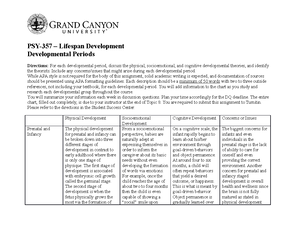- Information
- AI Chat
Was this document helpful?
PSY-357 Issues on Dying Worksheet
Course: Lifespan Development (PSY-357)
190 Documents
Students shared 190 documents in this course
University: Grand Canyon University
Was this document helpful?

PSY-357 – Lifespan Development
Topic 8 – Issues on Dying
Directions: This assignment has two parts. The first part of the assignment you will answer
questions and reflect on your opinion on end-of-life issues. For the second part of the
assignment, you will watch segments of the video “A Death of One’s Own” from Films on
Demand, found in class resources and summarize your thoughts as you reflect on issues
associated with end-of-life decisions. You should have a total of two to four outside scholarly
references.
Part 1:
Before viewing segments of the video “A Death of One’s Own” from Films on Demand, answer
the following questions in a minimum of 200 words, using scholarly sources cited with APA in-
text citations to support your explanations.
1. What is your opinion on end-of-life issues?
2. Do you believe people should have the right to choose to die? Why or why not?
What a person decides to do towards the end of their life may be highly divisive. There can
be difficulties when it comes to discussing the topics surrounding death with others.
Making arrangements for death and determining whether to put an end to it might involve
moral, religious, or even legal considerations (West, 2014). Most people who are
approaching the end of their lives are incapable of speaking for themselves, thus requiring
high-end care. There is no simple solution to the moral conundrums that certain healthcare
professionals and family members frequently encounter. Even though not everyone shares
my opinion, I do think that people should have the freedom to decide when they want to
end their life. I believe that people who are confronting an incurable medical condition
should be allowed to make their own decisions, and if they find themselves unable to do so
themselves, the people that are liable for them should respect the wants and preferences of
individuals who are approaching the end of their life. Effective communication is necessary
when making decisions of this sort (Pirchel, 2016). The patient, the caretakers, and their
loved ones must all communicate with one another. Despite what was mentioned in the
past, the person receiving treatment must actively participate in any choices that are made
today.
Part 2:
Watch the following segments of the video “A Death of One’s Own” from Films on Demand:
Chronic Disease: Progression of ALD (segment 2)
Death with Dignity: Assisted Suicide (segment 5)
Cost of Chronic Disease (segment 7)
Students also viewed
- PSY357-RS-Developmental Periods (2) (1) (1)
- PSY 357 T8 RS Developmental Periods
- PSY357-RS-Developmental Periods 2 copy copy
- PSY-357-T8-RS-Issueson Dying Workshirections: This assignment has two parts. The first part of the assignment you will answer questions and reflect on your opinion on end-of-life issues. For the eet 2
- END OF LIFE Decisions - educative essay of lifespan choices
- Adolescence and Peer pressure











